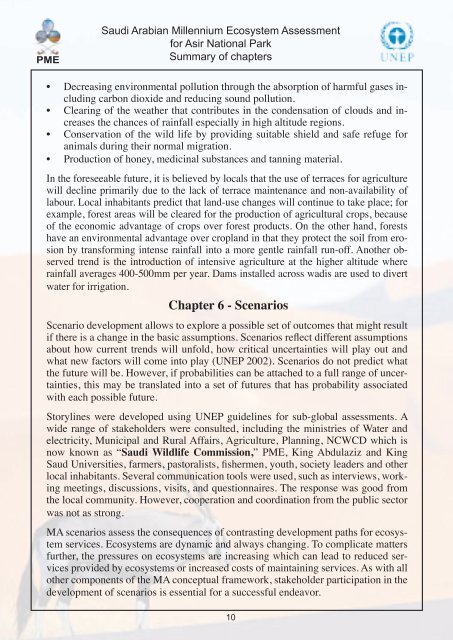MILLENNIUM ECOSYSTEM ASSESSMENT
MILLENNIUM ECOSYSTEM ASSESSMENT
MILLENNIUM ECOSYSTEM ASSESSMENT
You also want an ePaper? Increase the reach of your titles
YUMPU automatically turns print PDFs into web optimized ePapers that Google loves.
PMESaudi Arabian Millennium Ecosystem Assessmentfor Asir National ParkSummary of chapters• Decreasing environmental pollution through the absorption of harmful gases includingcarbon dioxide and reducing sound pollution.• Clearing of the weather that contributes in the condensation of clouds and increasesthe chances of rainfall especially in high altitude regions.• Conservation of the wild life by providing suitable shield and safe refuge foranimals during their normal migration.• Production of honey, medicinal substances and tanning material.In the foreseeable future, it is believed by locals that the use of terraces for agriculturewill decline primarily due to the lack of terrace maintenance and non-availability oflabour. Local inhabitants predict that land-use changes will continue to take place; forexample, forest areas will be cleared for the production of agricultural crops, becauseof the economic advantage of crops over forest products. On the other hand, forestshave an environmental advantage over cropland in that they protect the soil from erosionby transforming intense rainfall into a more gentle rainfall run-off. Another observedtrend is the introduction of intensive agriculture at the higher altitude whererainfall averages 400-500mm per year. Dams installed across wadis are used to divertwater for irrigation.Chapter 6 - ScenariosScenario development allows to explore a possible set of outcomes that might resultif there is a change in the basic assumptions. Scenarios reflect different assumptionsabout how current trends will unfold, how critical uncertainties will play out andwhat new factors will come into play (UNEP 2002). Scenarios do not predict whatthe future will be. However, if probabilities can be attached to a full range of uncertainties,this may be translated into a set of futures that has probability associatedwith each possible future.Storylines were developed using UNEP guidelines for sub-global assessments. Awide range of stakeholders were consulted, including the ministries of Water andelectricity, Municipal and Rural Affairs, Agriculture, Planning, NCWCD which isnow known as “Saudi Wildlife Commission,” PME, King Abdulaziz and KingSaud Universities, farmers, pastoralists, fishermen, youth, society leaders and otherlocal inhabitants. Several communication tools were used, such as interviews, workingmeetings, discussions, visits, and questionnaires. The response was good fromthe local community. However, cooperation and coordination from the public sectorwas not as strong.MA scenarios assess the consequences of contrasting development paths for ecosystemservices. Ecosystems are dynamic and always changing. To complicate mattersfurther, the pressures on ecosystems are increasing which can lead to reduced servicesprovided by ecosystems or increased costs of maintaining services. As with allother components of the MA conceptual framework, stakeholder participation in thedevelopment of scenarios is essential for a successful endeavor.10


